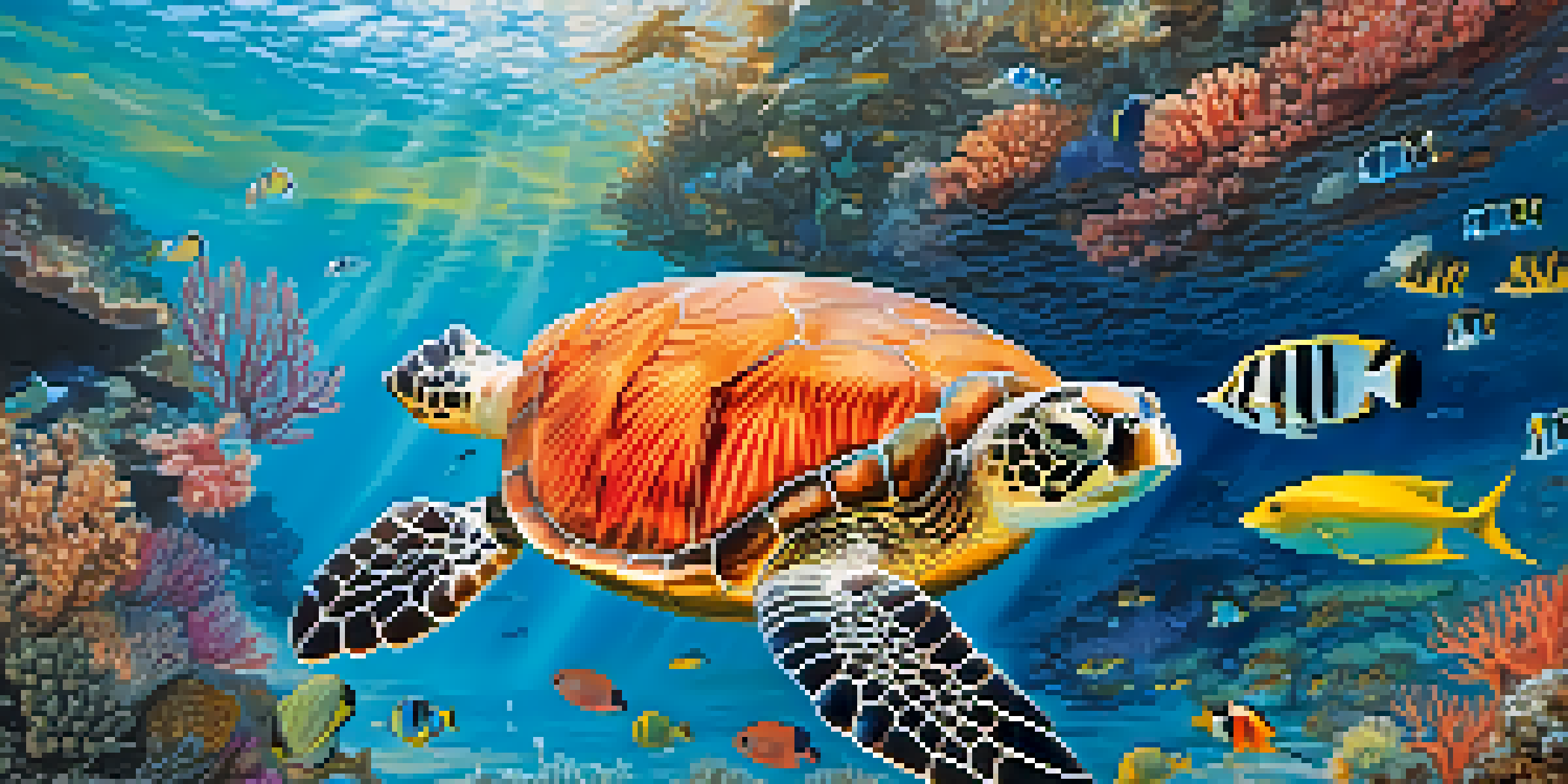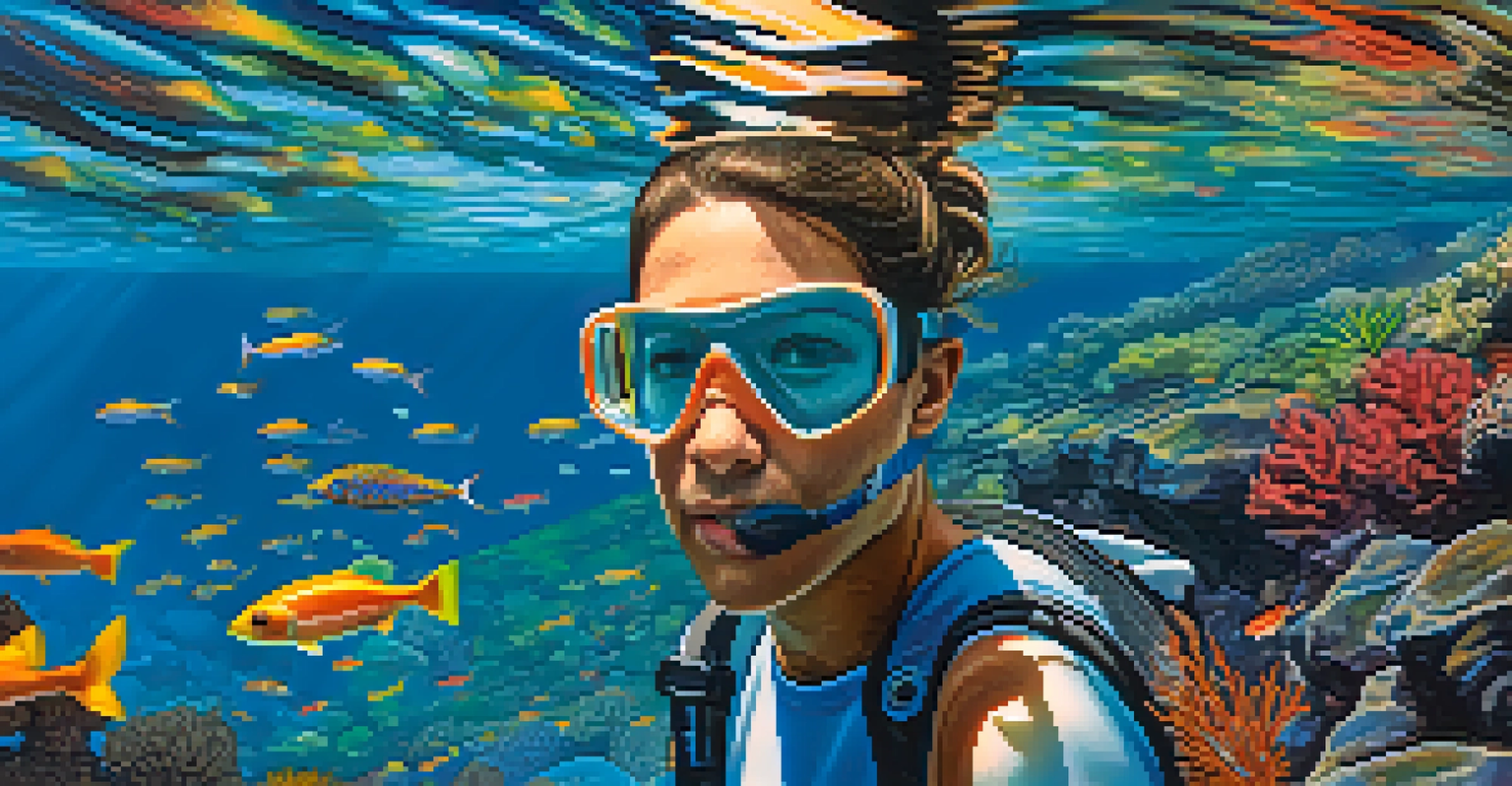Hawaii's Marine Life: Diversity of Oceanic Flora and Fauna

Introduction to Hawaii's Unique Marine Ecosystem
Hawaii is renowned for its breathtaking landscapes, but its underwater world is equally mesmerizing. The islands sit in the heart of the Pacific Ocean, home to diverse marine habitats that support a wealth of life. From vibrant coral reefs to deep-sea trenches, these waters boast an array of species found nowhere else on Earth.
The sea, once it casts its spell, holds one in its net of wonder forever.
The isolation of Hawaii has allowed unique species to evolve over millions of years. This biodiversity is not just striking; it's essential for maintaining the ecological balance of marine environments. Understanding these ecosystems is critical as they face growing threats from climate change and human activities.
In this article, we’ll dive into the different types of oceanic flora and fauna that make Hawaii’s marine life so special. Whether you're a snorkeler, diver, or simply an ocean enthusiast, there’s much to admire beneath the waves.
The Wonders of Coral Reefs in Hawaii
Coral reefs are often referred to as the 'rainforests of the sea' due to their rich biodiversity. In Hawaii, these reefs provide habitat for countless marine species, including colorful fish, sea turtles, and invertebrates. The warm waters and abundant sunlight create perfect conditions for coral growth, making these ecosystems incredibly vibrant.

However, coral reefs face significant challenges, including bleaching events caused by rising ocean temperatures. This phenomenon occurs when stressed corals expel the algae living in their tissues, leading to a loss of color and critical nutrients. Protecting these reefs is essential, as they not only support marine life but also protect shorelines from erosion.
Hawaii's Unique Marine Biodiversity
Hawaii's isolation has fostered a remarkable diversity of marine species, crucial for ecological balance.
Exploring Hawaii's coral reefs through snorkeling or diving offers an unforgettable glimpse into this underwater paradise. Witnessing the resilience of coral ecosystems inspires a deeper appreciation for the ocean's delicate balance.
Diverse Fish Species: A Colorful Underwater Gallery
Hawaii is home to an astounding variety of fish species, many of which are endemic to the islands. From the striking humuhumunukunukuāpuaʻa, Hawaii's state fish, to the graceful manta rays that glide through the waters, the diversity is astonishing. These colorful inhabitants play vital roles in maintaining the health of marine ecosystems.
We won't have a society if we destroy the environment.
The unique geography of Hawaii creates various habitats, such as lava formations and sandy bottoms, which support different fish communities. Each species has adapted to its environment, showcasing nature's incredible ingenuity. Observing these fish in their natural habitats can be a transformative experience, connecting us to the ocean's wonders.
Conservation efforts are crucial to ensure the survival of these fish populations, especially in the face of overfishing and habitat destruction. By practicing sustainable snorkeling and fishing, we can help protect these vibrant communities for future generations.
Seabirds: Guardians of Hawaii's Marine Ecosystem
Seabirds are an integral part of Hawaii's marine ecosystem, serving as indicators of ocean health. Species such as the Laysan albatross and the Hawaiian petrel rely on the ocean for food, often traveling great distances to forage. Their presence reflects the abundance and diversity of marine life in the surrounding waters.
These birds play a crucial role in nutrient cycling, as they transport nutrients from the ocean to land through their droppings. This process enriches the soil and supports plant life, demonstrating the interconnectedness of ecosystems. Observing seabirds in their natural habitat offers insights into the delicate balance of marine and terrestrial environments.
Threats to Coral Reefs
Coral reefs in Hawaii face significant challenges from climate change, emphasizing the need for conservation.
However, seabird populations are threatened by habitat loss and climate change. Protecting their nesting sites and ensuring healthy ocean ecosystems is vital for their survival and the overall health of Hawaii's biodiversity.
Marine Mammals: The Charismatic Giants of the Ocean
Hawaii's waters are frequented by various marine mammals, including dolphins, whales, and the endangered monk seal. These creatures captivate our imagination with their intelligence and social behaviors, often drawing visitors eager to witness them in the wild. The waters around Hawaii serve as a vital breeding ground for several whale species, including humpbacks.
Observing these magnificent animals in their natural habitats fosters a greater appreciation for marine conservation. Marine mammals play essential roles in maintaining the balance of ocean ecosystems, from regulating fish populations to contributing to nutrient cycling. Their presence is a testament to the health of the marine environment.
Unfortunately, these majestic creatures face numerous threats, such as entanglement in fishing gear and habitat degradation. Supporting conservation efforts and responsible tourism practices can help protect these iconic species for future generations to enjoy.
Invertebrates: The Unsung Heroes of Marine Diversity
While fish and marine mammals often steal the spotlight, invertebrates are the unsung heroes of Hawaii's marine ecosystems. Creatures like octopuses, sea urchins, and jellyfish play crucial roles in the food web and contribute to the overall health of marine environments. Their diverse forms and behaviors are fascinating to explore, revealing the complexity of ocean life.
Many invertebrates, such as the Hawaiian crown-of-thorns starfish, are essential for coral reef health, while others serve as prey for larger animals. Each species has adapted uniquely to its environment, showcasing nature's creativity. Understanding the roles of these creatures helps us appreciate the intricate web of life beneath the waves.
Importance of Conservation Efforts
Active conservation initiatives are essential to protect Hawaii's marine life and ensure its survival for future generations.
However, invertebrate populations are also at risk from pollution and habitat destruction. By advocating for cleaner oceans and responsible fishing practices, we can help ensure that these vital species continue to thrive in Hawaii's waters.
Conservation Efforts: Protecting Hawaii's Marine Life
With the growing threats to marine ecosystems, conservation efforts in Hawaii are more important than ever. Organizations, local communities, and government agencies are working tirelessly to protect marine habitats and restore populations of endangered species. Initiatives like marine protected areas and community-led restoration projects are making a positive impact.
Education and awareness play critical roles in these conservation efforts. Engaging locals and visitors in understanding the importance of preserving marine life fosters a culture of stewardship. Every action counts, from reducing plastic use to participating in beach clean-ups; everyone can contribute to the health of Hawaii's oceans.

As we strive to protect Hawaii's unique marine biodiversity, it is crucial to recognize our responsibility to future generations. By supporting conservation initiatives and making sustainable choices, we can help preserve the beauty and diversity of Hawaii's marine life.